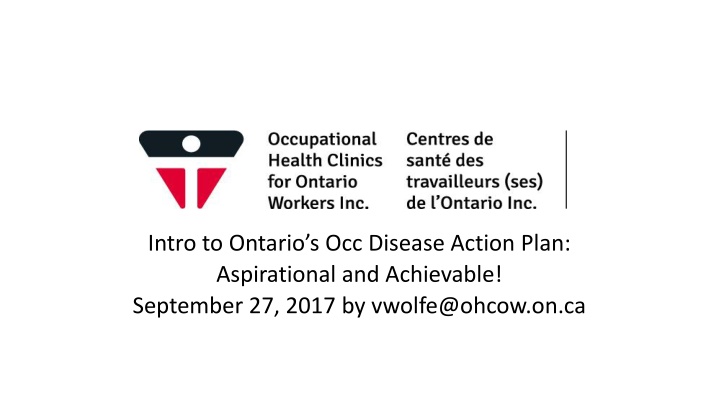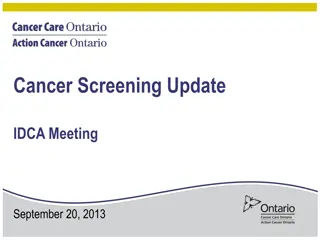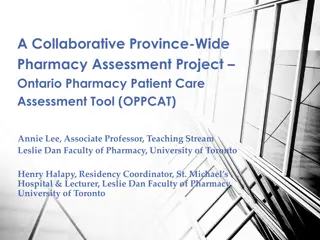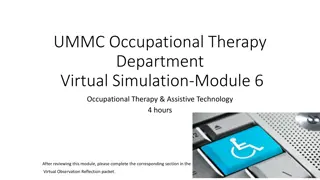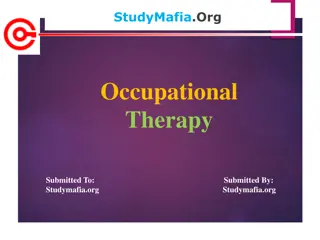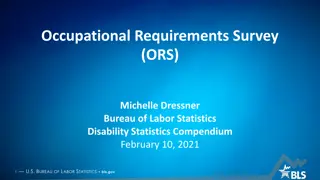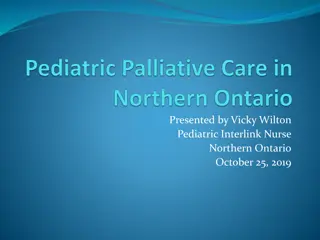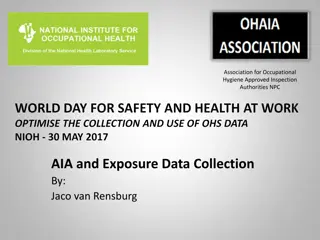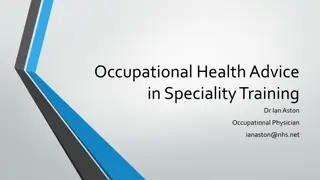Ontario's Occupational Disease Action Plan - Overview and Priorities
The Occupational Disease Action Plan in Ontario aims to reduce illnesses and fatalities associated with occupational diseases. The plan focuses on evidence-based priorities, current status, implementation challenges, and the importance of prevention. It addresses the need for a strategic approach to address occupational exposures and strengthen surveillance systems for effective prevention efforts.
Download Presentation

Please find below an Image/Link to download the presentation.
The content on the website is provided AS IS for your information and personal use only. It may not be sold, licensed, or shared on other websites without obtaining consent from the author.If you encounter any issues during the download, it is possible that the publisher has removed the file from their server.
You are allowed to download the files provided on this website for personal or commercial use, subject to the condition that they are used lawfully. All files are the property of their respective owners.
The content on the website is provided AS IS for your information and personal use only. It may not be sold, licensed, or shared on other websites without obtaining consent from the author.
E N D
Presentation Transcript
Intro to Ontarios Occ Disease Action Plan: Aspirational and Achievable! September 27, 2017 by vwolfe@ohcow.on.ca
Introduction Objectives and Need for a plan Research & Data Review to Frame Direction Reference Group Ranking of Exposures 5 Priorities ODAP by Approach ODAP Implementation Challenges, Feedback & Discussion Occupational Health Clinics for Ontario Workers Inc. Prevention Through Intervention
Occupational Disease Action Plan: Objective and Current Status Objective: To develop a system partner action plan aimed at reducing illnesses and fatalities associated with occupational diseases in Ontario workplaces The priorities determined based on the best available evidence (research and data sources), the current environment, and where the best opportunities exist to have an impact The Action Plan to build upon previous and ongoing work related to occupational disease and look for opportunities to address gaps in prevention. Current Status: The Occupational Disease Action Plan was finalized in December and implementation began in Jan. Confirmed System Priority for 17/18 & 18/19 Occupational Health Clinics for Ontario Workers Inc. Prevention Through Intervention 3
Why an Occ Disease Action Plan? In 2015, there were 154 occupational disease deaths in Ontario, compared to 72 traumatic fatalities (Day of Mourning Fatalities Report). Occupational disease fatalities have outnumbered traumatic fatalities in each of the past ten years, and have increased each year since 2012, while traumatic fatalities have decreased. Leading diseases resulting in deaths: Mesothelioma (34.5%), Lung Cancer (28.5%) Between 2006-2015 (WSIB Sch.1): ~125,000 occupational disease claims allowed, >$950M in benefit costs Long latency 3% claims, but >60% costs NIHL 23% of all claims All significantly lagging indicators, plus many, many deaths and illnesses unrecognized, unreported and/or not allowed *Sources: WSIB, By the Numbers, 2015 Occupational Health Clinics for Ontario Workers Inc. Prevention Through Intervention 4
Meeting of Occupational Disease Research/Data Experts Meeting of Occupational Disease Research/Data Experts Purpose: To recommend where prevention efforts should be focused based on severity and prevalence research. Research/Data Attendees: Centre for Research Expertise in Occ. Disease; Occ. Cancer Research Centre; Institute for Work and Health; Centre for Research in Occ. Health & Safety; Public Health Ontario; Workplace Safety & Insurance Board Based on the available data and evidence, the research experts recommended: Focusing on occupational exposures that lead to diseases vs. the diseases alone; Ensuring new and emerging risks are included in the list of priorities Strengthening surveillance systems to inform prevention efforts. Occupational Diseases Occupational Exposures Skin disease Respiratory disease (asthma) Noise induced hearing loss Cancer Infectious diseases Hand-arm vibration syndrome (HAVS) and other vibration related diseases Diesel engine exhaust Noise Allergens/irritants- Skin and Lung Asbestos Shift work Organic solvents Solar ultraviolet radiation Silica Occupational Health Clinics for Ontario Workers Inc. Prevention Through Intervention 5
Reference Group OHCOW Infrastructure Health and Safety Association (IHSA) Workplace Safety North (WSN) Workers Health and Safety Centre (WHSC) Workplace Safety and Prevention Services (WSPS) Public Services Health and Safety Association (PSHSA) Workplace Safety and Insurance Board (WSIB) Institute for Work and Health (IWH) Centre for Research Expertise in Occupational Disease (CRE-OD) Occupational Cancer Research Centre (OCRC) Public Health Ontario Ministry of Health and Long Term Care Ontario Lung Association (OLA) MOL, Operations Division (Occupational Health and Safety Branch, OHSB) MOL, Policy Division (Health and Safety Policy Branch, HSPB) MOL, Communications and Marketing Division (CMD) MOL, Prevention Division Occupational Health Clinics for Ontario Workers Inc. Prevention Through Intervention
Reference Group Consensus that there is a general lack of awareness among the health and safety system and workplace parties when it comes to occupational disease issues that needs to be addressed. Agreed to prioritize (through ranking) exposures that result in occupational disease in cases where: high volumes of workers are exposed; short-term outcomes are attainable/measurable ; and capacity and opportunity exists for intervention Consensus to build new collaborative initiatives, and not lose site of emerging exposures (e.g. nanotechnology), particularly where knowledge exchange and research may not yet be fully developed. Occupational Health Clinics for Ontario Workers Inc. Prevention Through Intervention
Priority Ranking: Overall Ranking (total Priority Ranking: Overall Ranking (total Rank scores) scores) Exposure Total Need Impact Noise 75 1 45 30 Allergens/Irritants 102 2 48 54 Diesel 105 3 50 55 Asbestos 127 4 59 68 Silica 154 5 75 79 Solar 158 6 87 71 O. Solvents 188 7 95 93 Heat 190 8 99 91 Shift Work 197 9 91 106 Nanotechnology 215 10 104 111 Radiation 250 11 124 126 Radon 267 12 137 130 Occupational Health Clinics for Ontario Workers Inc. Prevention Through Intervention 8
ODAP Priorities ODAP Priorities General Occupational Disease Awareness Noise Allergens & Irritants (both skin & lung) Diesel Exhaust Emissions Emerging Issues Occupational Health Clinics for Ontario Workers Inc. Prevention Through Intervention
ODAP: Intelligence & Decision Support Develop a strategy to embed Occupation into EMR s requires partnership with MOHLTC & their contractors Develop a plan for obtaining baseline exposure data to focus and support action for prevention eg. pilot project? Mine existing exposure and disease surveillance data (eg. WSIB & ODSS) to set priorities and better target prevention effort Occupational Health Clinics for Ontario Workers Inc. Prevention Through Intervention
ODAP: Research & Data Management Conduct a scan to review OD legislation in other jurisdictions Conduct a scan of prevention strategies to reduce noise exposure Identify priority irritants and allergens for skin & lung disease to further focus AP activities ID emerging issues from current research & develop research questions for MOL ROP? Explore and evaluate workplace exposure assessment tools Assess worker irritant knowledge to target awareness efforts Occupational Health Clinics for Ontario Workers Inc. Prevention Through Intervention
ODAP: Awareness Develop & implement a communications and marketing plan focusing on raising awareness of harm and prevention with respect to the priority exposures: noise and/or allergens and irritants and/or diesel hazards in the workplace, with an underlying theme of general occupational disease prevention (17/18 & 18/19 System priority) Target specific sectors to raise awareness of priority allergens and irritants Preventoccdisease.ca? Occupational Health Clinics for Ontario Workers Inc. Prevention Through Intervention
ODAP: Advisory & Support Services Deliver educational opportunities and resources to build system knowledge and capacity re: priorities Target advisory & support services to workplaces falling under the expanded noise regulation Target advisory & support services on other AP priorities to specific sectors Occupational Health Clinics for Ontario Workers Inc. Prevention Through Intervention
ODAP: Education and Training Inventory and align system educational resources and training initiatives to promote occ. disease prevention. Initially focusing on the priorities of noise, allergens/irritants, diesel and general awareness ID gaps and a process to develop new resources or training initiatives to address & support ODAP implementation Review mandatory training initiatives and standards to id opportunities to add or strengthen OD content Occupational Health Clinics for Ontario Workers Inc. Prevention Through Intervention
ODAP: Education & Training contd Integrate priority hazard awareness into career counselling and vocational services (eg. Asthma triggers) Develop and deliver physician education on priority hazards + general OD (eg. Occupational Asthma) Provide/recommend tools to JHSC for health hazard id & management Occupational Health Clinics for Ontario Workers Inc. Prevention Through Intervention
ODAP: Enforcement, Legislation & Programs Develop enforcement strategies for occ disease priorities (eg. Noise, WHMIS, OELs ) Review and consider opportunities for regulatory change Explore NIOSH Buy Quiet program re: potential for Ontario Explore integration of OD into WSIB premium or prevention programs Explore opportunities to incorporate OD elements into accreditation (eg. Assurance of controls, ventilation etc.) Occupational Health Clinics for Ontario Workers Inc. Prevention Through Intervention
ODAP: Implementation Structure Implementation Team: Coordinated by Val Wolfe, OHCOW & Steven Grossman, PVO Sets principles (hierarchies of Prevention & Control), guides working groups Reviews implementation, especially broad goals Strategizes and plans Maintain momentum, expand and strengthen network 5 Working Groups: EMR; Intelligence & Data; Noise; Diesel Engine Exhaust; Allergens & Irritants Conduct environmental scan of current initiatives & perceptions Prioritize and activate relevant ODAP actions in that context Identify deliverables and quantifiable measures of success Occupational Health Clinics for Ontario Workers Inc. Prevention Through Intervention
ODAP WG: Noise Chair: Mike Russo, IHSA Initiated broad campaign on the hazards of noise in the workplace for International Noise Awareness Day, April 26 2017, with Avoid Noise wordmark, wide-scale social media, online campaign, including OHCOW tool for workplaces to upload (crowd-source) sound-levels Ongoing promotion (awareness, education) of noise at system conferences (e.g. Partners in Prevention), webinar series? System partner webpages and resources dedicated to noise created/updated MOL All Sector Provincial Noise Enforcement Initiative (April 1, 2017 March 31, 2018) Next meeting Sept. 2017 Occupational Health Clinics for Ontario Workers Inc. Prevention Through Intervention
ODAP WG: Diesel Chair: Mike Parent, WSN Symposium on diesel exhaust at WSN Mining Health and Safety Conference (April 2017). Table of hazards and hierarchy of controls developed by OCRC Infographics developed by WSN Lung Cancer & Prevention in Mining Conference July 2017 Mining Diesel Emissions Council Oct. 2017 Next mtg. Oct. 2017 Occupational Health Clinics for Ontario Workers Inc. Prevention Through Intervention
ODAP WG: Allergens & Irritants Chair: Linn Holness from CRE-OD assisted by Janet Brown & Andrea Stevens-Lavigne, OLA Reviewing research and data (e.g. academic literature, WSIB Data, Clinical Path Test Data, HSA consultant surveys, OHCOW cases, polled expert opinions) to determine focus areas for prevention work around lung and skin allergens and irritants Shortlist: Cleaning agents, Dust, Isocyanates , Animals, Bioaerosols, Wet work, Solvents, Epoxy, Preservatives Each IT member to rank & prioritize similar to ODAP Next meeting Oct. 2017 Occupational Health Clinics for Ontario Workers Inc. Prevention Through Intervention
ODAP WG: Data & Intelligence Chair: Victoria Arrandale, OCRC Liaising with new System Data Committee Identifying existing sources & questions for mining Big WSIB data ask including all submitted vs. just allowed Developing a plan (e.g. potential pilot project) for obtaining occupational exposure baseline data from Ontario workplaces to support action to prevent occ. disease Occupational Health Clinics for Ontario Workers Inc. Prevention Through Intervention
ODAP WG: Electronic Medical Records Chair: Henrietta Van Hulle Cultivating multi-level inter-ministerial discussions on adding occupation to EMRs Identifying intermediaries and opportunities to raise awareness of issue Developing a plan to promote the importance of tracking patient work-related information in Electronic medical records eg. Health Care & EMR user conferences Mtg. w. OntarioMD, possible eConsulting role for OHCOW Occupational Health Clinics for Ontario Workers Inc. Prevention Through Intervention
Timelines Winter 2017 Working Groups Created Spring 2017 Working Groups meet & plan Short-term activities begin Summer 2017 Activities develop and evolve; Quarterly IT review Fall 2017 Occ-tober Check- up Review priorities for Year 2 Occupational Health Clinics for Ontario Workers Inc. Prevention Through Intervention
Lets keep Occ-omplishing Together! ODAP has created energy and momentum to address large, complex, and poorly understood issues Efforts & success affected by many external and competing internal factors Think of IT as Orchestra, Working Groups as Chamber Orchestras, but what we need is a Choir. Partnerships Key welcome to the ODAP Choir! Challenge to achieve functional reach amidst noise Priorities and Activities reviewed annually; Input & ideas always welcome Watch for Occ-tober Symposium on Oct. 27th at CHSI Thanks for your interest and voice Occupational Health Clinics for Ontario Workers Inc. Prevention Through Intervention Prevention Through Intervention Occupational Health Clinics for Ontario Workers Inc.
Occ-tober, Oct. 27th @ CHSI Reach & Impact: Successful Strategies for Social Marketing, S. Rosa, PHO Beyond the Burden: From Cancer Risk to Reduction, Dr. P. Demers, OCRC Occ Disease Action Plan Update Nano Assessment & Exposure Prevention: National & International Perspectives, Dr. P. Rasmussen, Health Canada Getting the Lead Out: the Problem & Challenges Continue, M. Tew, K. Hedges, OHCOW Cluster Busting: Challenges, Approaches & Prevention Opportunities Occ-omplishments: StressAssess, Noise Tools, OELs, Blitz, Ergocalculator Occupational Health Clinics for Ontario Workers Inc. Prevention Through Intervention
